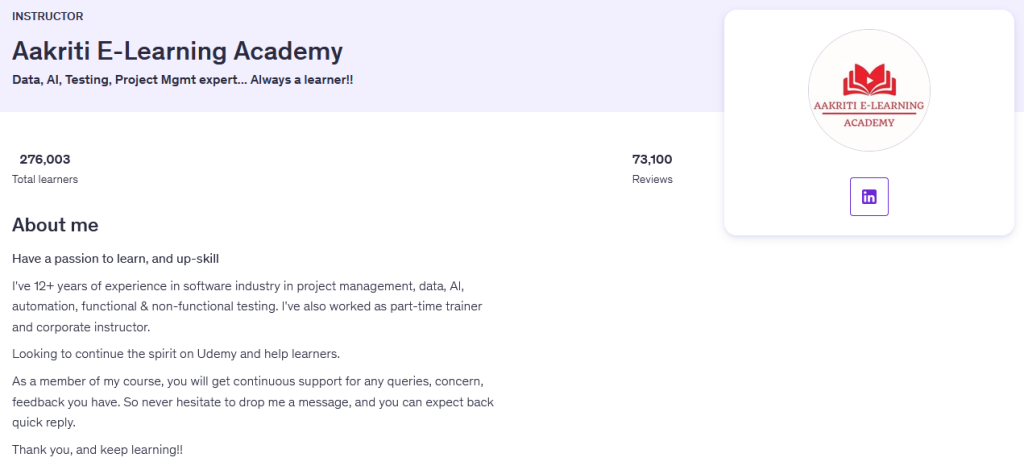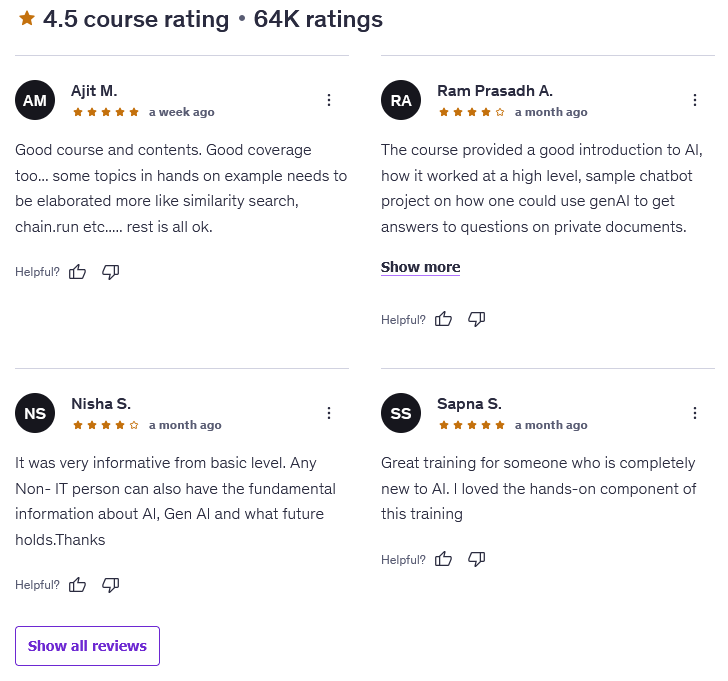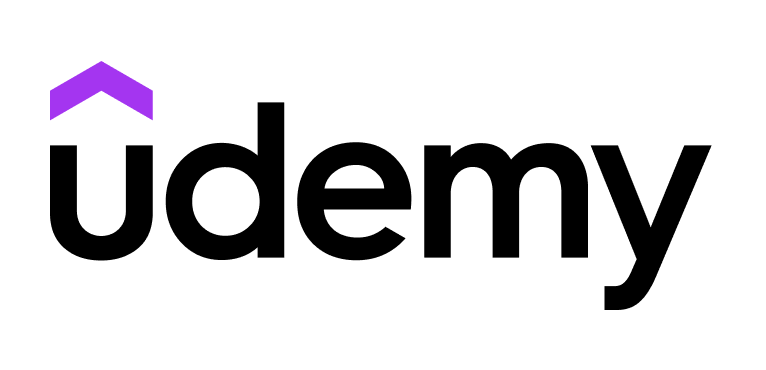If you’ve been hearing all the buzz about ChatGPT, prompt engineering, and “LLMs,” but still feel a little lost on where to begin — Generative AI for Beginners might be the perfect gateway into this fast-moving world. This Udemy course takes a down-to-earth approach to a topic that’s usually wrapped in complex math and jargon, turning it into something anyone can grasp.
The course mixes clear explanations, real industry examples, and a surprisingly fun hands-on chatbot project to show you what’s actually possible with generative AI. It’s less about memorizing terms and more about building intuition for how these systems work — and how you can start applying them yourself.
Instructor Reputation
When it comes to Udemy instructors, experience and teaching approach make all the difference — and Aakriti E-Learning Academy brings both in spades. Led by an instructor with over 12 years of industry experience across data, AI, automation, and project management, this course benefits from someone who doesn’t just talk about AI — she’s actually lived it in real business environments. That blend of technical skill and management insight shapes how she teaches, turning what could be dense AI theory into digestible, real-world knowledge.

The instructor’s resume reads like a cross between a tech lead and a coach. Before transitioning into full-time online education, she worked hands-on in the software industry, leading automation and AI initiatives, and also trained corporate teams in testing, analytics, and data systems. This combination shines through in her teaching style — structured like a training program, but delivered with the warmth of a mentor.
Her reputation on Udemy backs this up: over 276,000 students enrolled, 73,000+ reviews, and a 4.5-star average rating across five courses. That’s not an easy feat, especially in a field as competitive as AI education. Her audience includes everyone from total beginners to professionals brushing up on the latest AI tools, which speaks to how accessible and adaptable her teaching really is.
But what sets her apart most is her commitment to support. Students repeatedly mention how approachable and responsive she is. The promise of “lifetime query support” — often tossed around as a marketing gimmick in online learning — is taken seriously here. Learners report getting personal replies within 24–48 hours, even months after finishing the course. That’s rare, and it makes the learning experience feel less like a one-time purchase and more like joining a long-term mentorship community.
Her tone throughout the course is also worth noting. Rather than overwhelming you with technical precision or assuming prior coding experience, she emphasizes clarity over complexity. When she introduces advanced concepts like embeddings or fine-tuning, she connects them back to intuitive examples and real-life applications. You get the sense she genuinely wants students to understand what’s going on, not just passively consume slides or watch demos.
She also maintains a forward-looking attitude, discussing how learners can stay relevant in the post-Generative AI world — an important mindset as this field evolves faster than any other in tech. That sense of mentorship extends beyond the course content itself; she encourages curiosity, responsible use, and continuous self-learning, all of which resonate strongly with learners who are serious about career growth.
In short, Aakriti doesn’t just bring authority — she brings accessibility and accountability, two things most online instructors overlook. Her experience in real-world data and AI projects gives her the technical backbone, while her long-standing teaching record and responsiveness give her the credibility. She’s the kind of instructor who can make even the most intimidating AI concepts feel not just possible, but exciting.
Course Structure
The structure of Generative AI for Beginners is thoughtfully designed — it feels like a guided journey rather than a random playlist of AI topics. Everything builds on what came before, and by the end, you can actually trace how all the puzzle pieces fit together: from understanding what “generative” really means, to crafting your own chatbot that responds intelligently.

The course opens with a foundational overview of Generative AI — what it is, why it matters, and how it’s shaping industries today. It starts by breaking down intimidating concepts like LLMs (Large Language Models) into plain English, explaining how these models generate text, images, or code by predicting patterns from massive datasets. This is where the instructor’s beginner-friendly tone really shines: she doesn’t assume you’re a data scientist, just someone curious about AI.
From there, it moves into key building blocks like embeddings, prompt engineering, and fine-tuning. Each term isn’t just defined; it’s placed in context. For example, you’ll learn how embeddings are used to help AI “understand” meaning, or how prompt engineering can drastically improve responses from tools like ChatGPT. These sections also weave in mini-demos that help solidify what you’re learning — you see, not just hear, how things work.
Midway through, the course transitions from theory to hands-on implementation, where you’ll actually create a Generative AI chatbot. This section is the heart of the course and a major differentiator from most beginner AI tutorials. You’ll go through step-by-step guidance to connect a model to your chatbot logic, test prompts, and interact with it live. It’s designed so that even non-technical learners can follow along, but if you have a programming background, there’s room to experiment more deeply. The use of OpenAI tools and APIs makes it directly relevant to today’s real-world applications.
The structure is also modular, meaning you can move at your own pace. Don’t want to do the coding part? You can skip it without breaking your understanding of the core concepts. Just want to explore ethical implications or future trends? Those are covered too, with thoughtful discussions about where Generative AI is headed — including risks, responsible use, and potential career paths that are emerging right now.
Another standout aspect is how the instructor ties industry use cases into nearly every section. You’ll learn how generative AI is being used in marketing, software development, customer support, education, and retail, with specific examples that make it easy to connect the dots to your own field. This keeps the material grounded, showing that AI isn’t some abstract concept — it’s a practical tool already reshaping the professional world.
Finally, the course wraps up with a “Future Trends and Continuous Learning” module. It helps you see AI as an evolving journey, not a one-and-done skill. You get a roadmap for staying relevant — which platforms to explore, what communities to join, and which technologies to watch next. That emphasis on long-term growth makes this course more than just an introduction — it’s an orientation to the mindset of lifelong AI learning.
All in all, the structure of Generative AI for Beginners reflects exactly what its title promises: a carefully built bridge between curiosity and capability. Whether you’re a business professional exploring how to use AI at work or a hobbyist experimenting with your first chatbot, this course guides you every step of the way — no fluff, no filler, just a clear path from zero to confident beginner.
Content Quality
When it comes to content, Generative AI for Beginners really shines where it matters most: making complex AI ideas understandable, actionable, and genuinely engaging. Generative AI can feel overwhelming when you’re first starting out — there’s a lot of jargon floating around (LLMs, embeddings, tokenization, fine-tuning, etc.), and most beginners don’t know where to start. What this course does beautifully is translate those intimidating concepts into language that’s both friendly and meaningful, without watering anything down.

The first few modules set the tone perfectly. Instead of throwing technical definitions at you, the instructor walks you through what Generative AI actually does, why it matters, and how it’s being used in the real world. This context makes the subject come alive. It’s not “AI in theory,” it’s “AI in action.” For instance, when she discusses large language models, she doesn’t just say they “generate text” — she connects that to how ChatGPT or similar tools are transforming customer support, marketing, and even personal productivity. That relevance keeps you hooked from the very beginning.
As you move deeper into the course, the focus gradually shifts from foundational theory to practical understanding. The prompt engineering section is particularly strong. It teaches you not just how to write better prompts, but how to think like the model — how to anticipate responses, structure inputs, and fine-tune for quality output. That’s a rare skill, and the course nails it with clear demonstrations and plenty of examples that help you build intuition.
The hands-on chatbot project deserves special mention. Even though it’s technically optional, it’s where the course transforms from “learning about AI” to actually doing AI. You’ll use OpenAI tools to create a functional chatbot — something you can tweak, test, and learn from. The project is guided with step-by-step explanations, so even if you’ve never coded before, you can still follow along comfortably. For more experienced learners, there’s flexibility to dive deeper and experiment. This part of the course delivers that satisfying “aha” moment — the point where you stop being just a learner and start feeling like a creator.
One of the strongest qualities of this course is its balance between depth and approachability. Many beginner AI courses either stay too shallow (oversimplified slides, no real-world context) or go too deep (full of code and math). This course finds that perfect middle ground. You get enough depth to feel like you’re actually learning something substantial, but it’s presented so clearly that you never feel lost. Each topic builds naturally on the last — from understanding models, to embeddings, to prompt logic, to practical implementation — so by the time you finish, you’ve absorbed a complete learning arc.
Students also appreciate how inclusive the teaching style is. Non-technical learners feel at ease because the instructor always provides visual examples and step-by-step reasoning. At the same time, professionals coming from tech or data backgrounds find that the material still adds value — especially in the sections discussing industry applications and ethical considerations. You get to see how Generative AI is being applied in sectors like education, e-commerce, software development, and healthcare, with use cases that spark creative ideas for your own projects.
Another standout feature is the lifetime query support, which greatly enhances the course’s educational value. In a field that’s evolving as rapidly as AI, questions don’t stop when the videos end — and having access to continuous instructor support keeps your learning relevant even months later. Several reviewers specifically praised how fast and detailed the instructor’s replies were, helping them troubleshoot hands-on exercises or clarify conceptual doubts.
If there’s one small area for improvement, it’s depth in a few advanced areas like similarity search or LLM chaining. A handful of students mentioned wanting more elaboration there. But that’s less a flaw and more an opportunity for a future “intermediate” version of the course — because the groundwork this course lays is rock-solid.
In summary, the content in Generative AI for Beginners is not just educational — it’s empowering. It doesn’t teach you to fear AI, it teaches you to use it. You’ll walk away not only understanding how generative AI works but also feeling confident about applying it in your career, business, or personal projects. It’s one of those rare courses where the learning sticks, because it’s tied to purpose, not just memorization.
Overall Course Rating – 9.2/10
If we had to put a number on it, Generative AI for Beginners earns a 9.2 out of 10 — and that’s well deserved.
From start to finish, this course feels like a carefully guided introduction into one of the most transformative technologies of our time. It’s approachable enough for absolute beginners, yet insightful enough to keep even tech-savvy learners engaged. The pacing is steady, the explanations are clear, and the real-world examples make sure you never lose sight of why what you’re learning actually matters.

One of the biggest reasons it scores so high is the instructor’s teaching style. She manages to maintain that perfect balance between friendliness and authority — you trust her knowledge, but she never makes you feel out of your depth. Every topic is taught as if you’re sitting beside her in a workshop, not watching from behind a screen. That conversational delivery makes technical concepts like embeddings, model tuning, and tokenization feel surprisingly accessible.
Another reason this course earns its rating is the hands-on design. The chatbot project isn’t just a side exercise — it’s the anchor that brings the whole learning experience together. It bridges the gap between curiosity and competence. Many learners finish the course not only understanding what Generative AI is, but also having built something tangible with it. That shift from passive understanding to active application is what makes the course stand out among the sea of AI intros out there.
The production quality also deserves a nod. The visuals, flow, and explanations are clean and to the point. Each video feels intentionally crafted — not rushed, not filler. And unlike some AI courses that get outdated quickly, this one stays relevant by emphasizing concepts over specific tools. You’re not just learning “how to use ChatGPT” — you’re learning the logic that applies to any modern LLM or AI system. That makes the value of this course more durable over time.
Of course, there’s room for minor improvements. Advanced learners might wish for a bit more technical deep-dives or coding demonstrations. But considering this course is explicitly targeted at beginners, that trade-off feels fair. The simplicity is part of what makes it so effective. It’s the kind of course that builds a solid foundation — one that prepares you to comfortably move on to more advanced AI and machine learning courses later.
In a crowded space full of overhyped “AI for beginners” classes, Generative AI for Beginners manages to stand out by being genuinely practical, well-paced, and refreshingly supportive. Whether you’re a student curious about the field, a professional looking to upskill, or just someone trying to understand what all the hype around AI is about, this course gives you exactly what you need — no fluff, no filler, just quality learning.
If you’ve been meaning to start your AI journey but have been waiting for the right course — this is it. Generative AI for Beginners is that rare blend of clarity, practicality, and inspiration that leaves you feeling not just informed, but capable.



